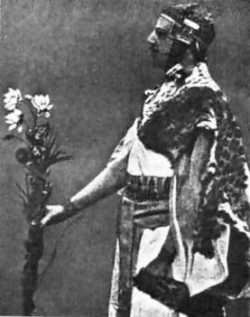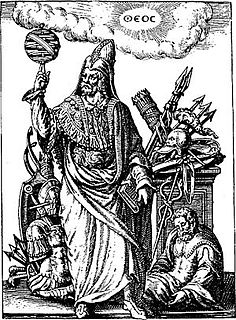
Aleister Crowley was an English occultist, ceremonial magician, poet, painter, novelist, and mountaineer. He founded the religion of Thelema, identifying himself as the prophet entrusted with guiding humanity into the Æon of Horus in the early 20th century. A prolific writer, he published widely over the course of his life.

The Hermetic Order of the Golden Dawn, more commonly the Golden Dawn, was a secret society devoted to the study and practice of the occult, metaphysics, and paranormal activities during the late 19th and early 20th centuries. Known as a magical order, the Hermetic Order of the Golden Dawn was active in Great Britain and focused its practices on theurgy and spiritual development. Many present-day concepts of ritual and magic that are at the centre of contemporary traditions, such as Wicca and Thelema, were inspired by the Golden Dawn, which became one of the largest single influences on 20th-century Western occultism.

Thelema is a Western esoteric and occult social or spiritual philosophy and new religious movement founded in the early 1900s by Aleister Crowley (1875–1947), an English writer, mystic, occultist, and ceremonial magician. The word thelema is the English transliteration of the Koine Greek noun θέλημα, "will", from the verb θέλω : "to will, wish, want or purpose."

777 and Other Qabalistic Writings of Aleister Crowley is a collection of papers written by Aleister Crowley. It is a table of magical correspondences. It was edited and introduced by Dr. Israel Regardie, and is a reference book based on the Hermetic Qabalah.

Ceremonial magic encompasses a wide variety of rituals of magic. The works included are characterized by ceremony and numerous requisite accessories to aid the practitioner. It can be seen as an extension of ritual magic, and in most cases synonymous with it. Popularized by the Hermetic Order of the Golden Dawn, it draws on such schools of philosophical and occult thought as Hermetic Qabalah, Enochian magic, Thelema, and the magic of various grimoires. Ceremonial magic is part of Hermeticism and Western esotericism.
The Babalon Working was a series of magic ceremonies or rituals performed from January to March 1946 by author, pioneer rocket-fuel scientist and occultist Jack Parsons and Scientology founder L. Ron Hubbard. This ritual was essentially designed to manifest an individual incarnation of the archetypal divine feminine called Babalon. The project was based on the ideas of Aleister Crowley, and his description of a similar project in his 1917 novel Moonchild.
The Lesser Key of Solomon, also known as Lemegeton Clavicula Salomonis or simply Lemegeton, is an anonymous grimoire on demonology. It was compiled in the mid-17th century, mostly from materials a couple of centuries older. It is divided into five books—the Ars Goetia, Ars Theurgia-Goetia, Ars Paulina, Ars Almadel, and Ars Notoria.

Francis Israel Regardie was an English occultist, ceremonial magician, and writer who spent much of his life in the United States. He wrote fifteen books on the subject of occultism.

Enochian magic is a system of ceremonial magic based on the 16th-century writings of John Dee and Edward Kelley, who wrote that their information, including the revealed Enochian language, was delivered to them directly by various angels. Dee's journals contain the record of these workings, the Enochian script, and the tables of correspondences used in Enochian magic. Dee and Kelley believed their visions gave them access to secrets contained within the Book of Enoch.

Samuel Liddell MacGregor Mathers, born Samuel Liddell Mathers, was a British occultist. He is primarily known as one of the founders of the Hermetic Order of the Golden Dawn, a ceremonial magic order of which offshoots still exist. He became so synonymous with the order that Golden Dawn scholar Israel Regardie observed in retrospect that "the Golden Dawn was MacGregor Mathers."

Kenneth Grant was an English ceremonial magician and advocate of the Thelemic religion. A poet, novelist, and writer, he founded his own Thelemic organisation, the Typhonian Ordo Templi Orientis—later renamed the Typhonian Order—with his wife Steffi Grant.
William Breeze, also known by his neo-Gnostic bishop title of Tau Silenus is an American author and publisher on magick and philosophy. He is the Sovereign Patriarch, or supreme governing cleric, of Ecclesia Gnostica Catholica (E.G.C.), the liturgical arm of Ordo Templi Orientis (O.T.O.), of which he is the current Outer Head of the Order (OHO), also known as Frater Superior, as well as caliph, the order's international leader. In this capacity he is a leading editor of the occult works of Aleister Crowley, the founder of the philosophy and religion of Thelema, who is regarded as its prophet.

A lamen is a magical pendant or breastplate worn around the neck so that it hangs upon the breast over the heart. Its uses vary but, most commonly, the term refers to a symbol of authority and a focus of magical energies. Aleister Crowley described the lamen as "a sort of coat of arms. It expresses the character and powers of the wearer." Crowley and DuQuette have proposed that the magical lamen might be a modern adaptation of the priestly breastplate of the ancient Hebrews.
Abramelin oil, also called Oil of Abramelin, is a ceremonial magic oil blended from aromatic plant materials. Its name came about due to its having been described in a medieval grimoire called The Book of Abramelin written by Abraham the Jew. The recipe is adapted from the Jewish Holy anointing oil of the Tanakh, which is described in the Book of Exodus (30:22-25) attributed to Moses.
Aiwass is the name given to a voice that the English occultist and ceremonial magician Aleister Crowley reported to have heard on April 8, 9, and 10 in 1904. Crowley reported that this voice, which he considered originated with a non-corporeal being, dictated a text known as The Book of the Law or Liber AL vel Legis to him during his honeymoon in Cairo.

In ceremonial magic, a magical formula or a word of power is a word that is believed to have specific supernatural effects. They are words whose meaning illustrates principles and degrees of understanding that are often difficult to relay using other forms of speech or writing. It is a concise means to communicate very abstract information through the medium of a word or phrase.
Richard Kaczynski is an American writer and lecturer in the fields of social psychology, metaphysical beliefs and new religious movements. He is known for his biography of the occultist Aleister Crowley, Perdurabo: The Life of Aleister Crowley, described by The Times Literary Supplement as "the major biography to date", and by Didrik Søderlind in the Norwegian daily Aftenposten as the best biography of Crowley.

Hermetic Qabalah is a Western esoteric tradition involving mysticism and the occult. It is the underlying philosophy and framework for magical societies such as the Golden Dawn, Thelemic orders, mystical-religious societies such as the Builders of the Adytum and the Fellowship of the Rosy Cross, and is a precursor to the Neopagan, Wiccan and New Age movements. The Hermetic Qabalah is the basis for Qliphothic Qabala as studied by left hand path orders, such as the Typhonian Order.
Therion (thēríon) is a deity found in the mystical system of Thelema, which was established in 1904 with Aleister Crowley's writing of The Book of the Law. Therion's female counterpart is Babalon, another Thelemic deity. Therion, as a Thelemic personage, evolved from that of "The Beast" from the Book of Revelation, whom Crowley identified himself with since childhood, because his mother called him that name. Indeed, throughout his life he occasionally referred to himself as “Master Therion” or sometimes “The Beast 666”. He wrote:
Before I touched my teens, I was already aware that I was THE BEAST whose number is 666. I did not understand in the least what that implied; it was a passionately ecstatic sense of identity.

Stephen Skinner is an Australian author, editor, publisher and lecturer. He is known for authoring books on magic, feng shui, sacred geometry and alchemy. He has published more than 46 books in more than 20 languages.














